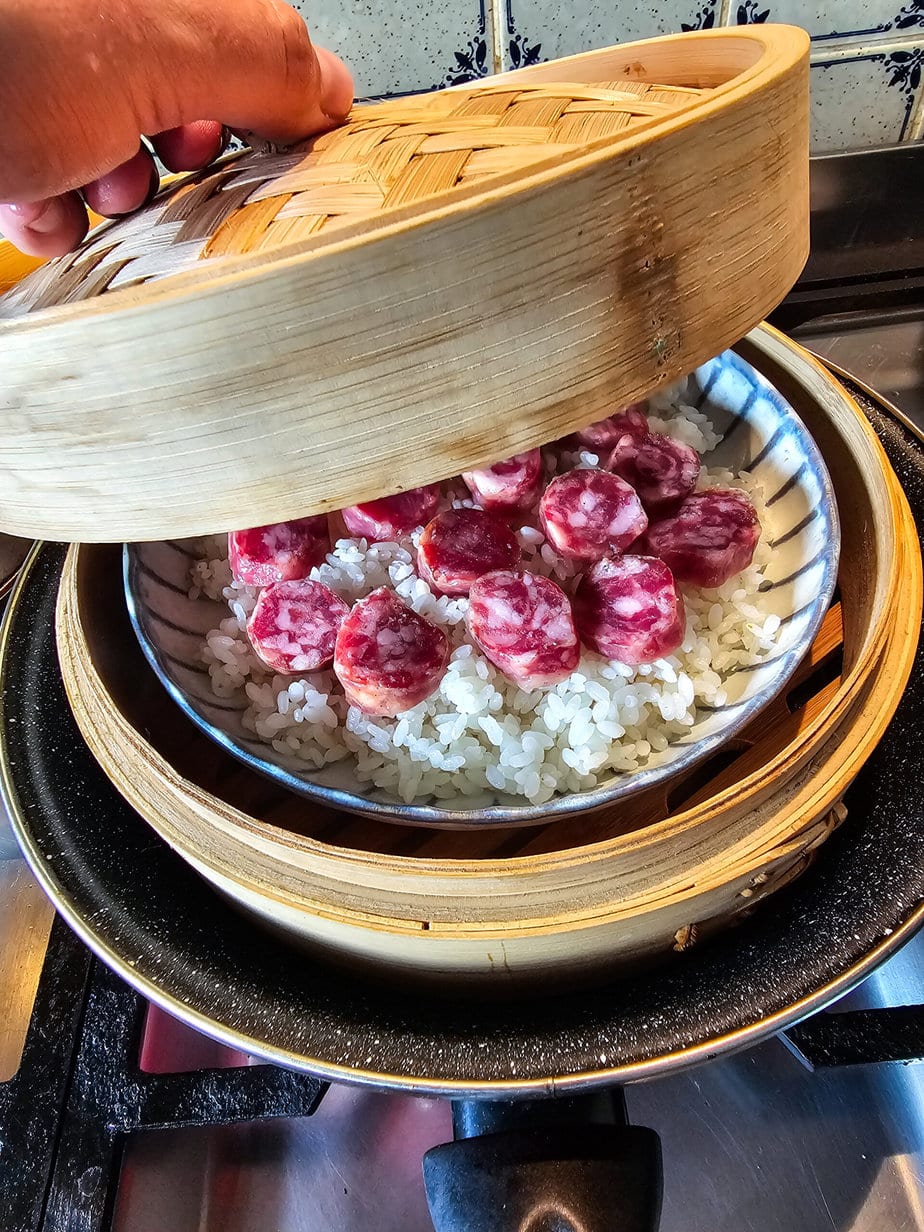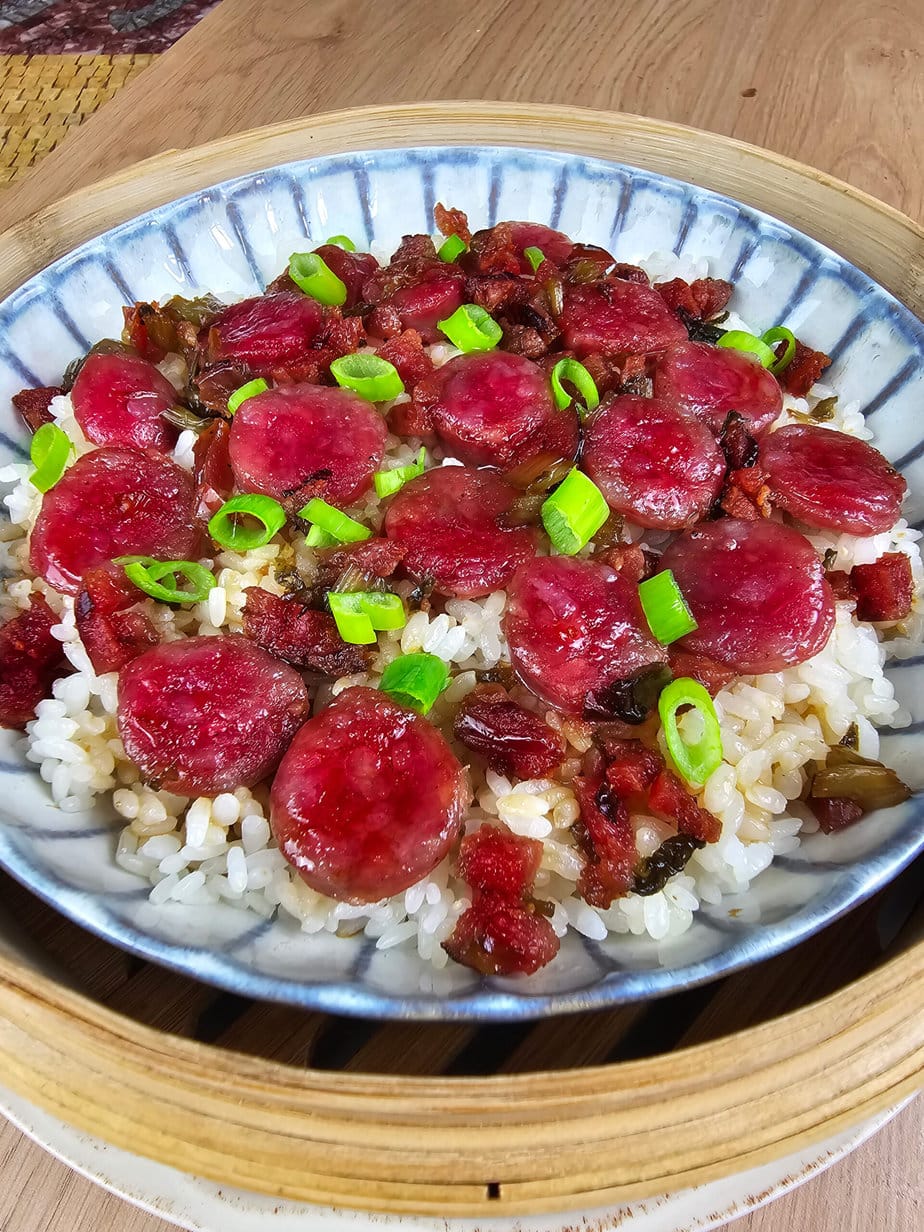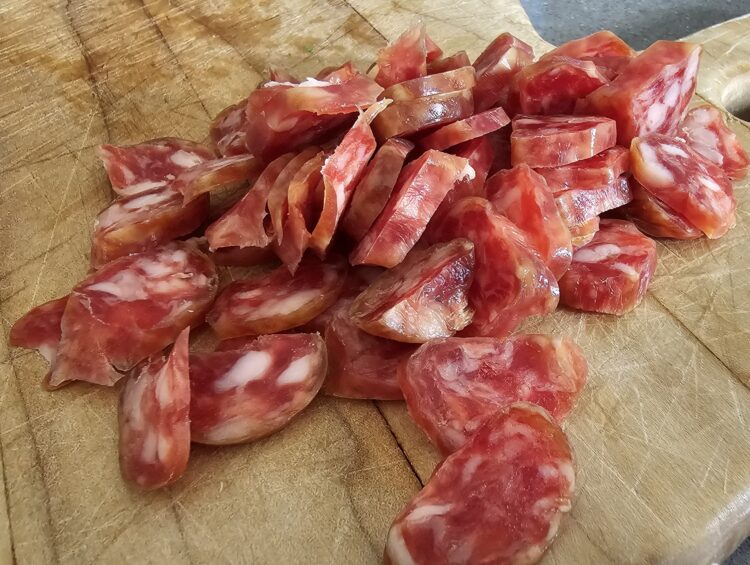The term “Chinese sausage” encompasses a range of sausages originating from China, each one specific to a region. The best known is the Cantonese sausage, called lap cheong or lap chong (1d8178), which literally means “winter stuffed intestine” or “waxed intestine” in Cantonese.
Over time, the name “lap cheong” has come to refer not only to various Chinese sausages but also to similar sausages made in other Asian countries. This article, however, focuses on the original Cantonese lap cheong.
Lap Cheong: What Exactly Is It?
Lap cheong, written la chang (14a0a0) in simplified Chinese and known as lap xuong in Vietnamese, is made by stuffing pork intestines with seasoned minced pork, then drying the links. Typical seasonings include Shaoxing wine, sugar and soy sauce, among others.
Traditionally, pork meat and fat are minced and seasoned during the autumn harvest, stuffed into casings, and then air-dried in the cold winter wind. The result is a firm, dense yet surprisingly tender sausage with the iconic red-and-white marbling.
Today, lap cheong is enjoyed across Asia and in many Western countries. Some makers replace the pork with chicken or beef, and livers of various kinds are sometimes added for extra depth.

Origins of the Lap Xuong Sausage
According to the Qimin Yaoshu, the earliest Chinese agricultural encyclopedia compiled by Jia Sixie in 544 AD, lap cheong may have appeared during the Wei and Jin dynasties, between 300 and 500 AD.
At that time people began preserving meat for the Lunar New Year by turning it into sausages, a practice that has continued ever since.
The modern Cantonese version was created in 1894 by the owner of a congee shop in Canton, who stuffed casings with leftover pork and pork liver from his kitchen.
What Does Lap Cheong Taste Like?
Though lap cheong resembles Italian salami, its flavor is quite different and shifts with the exact seasonings.
Most versions balance sweet and salty notes and are perfumed with Mei Gui Lu Jiu, a sorghum spirit infused with rose syrup that lends lap cheong its signature bouquet.
How to Use Chinese Sausage in Cooking?
Lap cheong is widely used in Chinese cuisine as well as in Vietnamese and Thai cuisines, and it works in countless dishes. Steam it, stir-fry it, or simply serve it with rice. As it cooks, the rendered fat coats the grains, giving the rice a silky mouthfeel and a subtle sweetness.
You can also add it to fried rice, noodles, soups or mixed stir-fries. For inspiration, see my recipes for steamed rice with Chinese sausages or fried rice with Chinese sausage. It is, of course, a key ingredient in Cantonese rice.

Lap cheong also appears in some mooncake and Pia cake recipes. Just be sure to cook the sausage well, as the meat is raw before curing.
In China it is enjoyed year-round, with consumption peaking in February. Many families see it as an indispensable treat during the Chinese New Year celebrations.
Where to Buy Chinese Sausage?
In the West you can buy lap cheong online or in Asian supermarkets, where a wide range of brands and flavors is stocked. The most popular varieties are the Mei Gui Lu and five-spice versions sold by You Huy, Hoa Nam, Viet Hung, and others.
For the most authentic taste, look for the Mei Gui Lu style (Mai Que Lo in Vietnamese). Of course, you can also make lap cheong at home if you prefer.

How to Store Chinese Sausage?
Whether homemade or store-bought, lap cheong should be stored in the refrigerator or freezer. Kept cold, it will stay in good condition for three months to a year, but always check and respect the date on the package.
What Can You Replace Chinese Sausage With?
Because of its distinctive flavor, lap cheong is hard to replace. Your best bet is to thinly slice a semi-soft dry sausage such as fuet — or “pipes ardennaises” for Belgians — and marinate it in a mixture of five-spice powder, sugar and Shaoxing wine.

